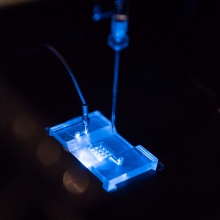The research project entitled "Microstructure-determined self assembly of biomimetic membranes" is developing a novel method for the production of planar arrays of hydrogel-based biomimetic membranes based on phospholipids or amphiphilic block copolymers. For this purpose, the known self-organization process will be programmed, determined and stabilized on the basis of the hydrophobic effect with the aid of microstructures, which contain components for the electrical contacting and optical addressing of the membranes. In the resulting array structures, membrane proteins can be examined simultaneously in high throughput at single molecule resolutionm both optically and electrically. The basic idea is to simplify and to accelerate, and at the same time, to control the nanoscale self-organization process by means of boundary conditions on the micrometer scale, which takes place during the formation of the already known droplet hydrogel bilayers (DHBs).
Two working groups are involved in this interdisciplinary project: The Nussberger group (Biophysics, Stuttgart) has experience with electro-optical derivations of DHBs. The Behrends Group (Membrane Physiology and Technology, Freiburg) has long been successful in establishing microsystems for electrophysiological high-throughput analysis of and with membrane proteins (chip-based automated cellular electrophysiology and synthetic membrane arrays). Both research groups aim to advance the development of membrane microstructures for self-assembled membrane arrays that are electrically and optically addressable with single molecule resolution. The project will culminate in a novel biochip (MECHIB) that combines high-resolution electrophysiology with single-molecule fluorescence in array format. In the long run, this new tool will enable the parallel and automated analysis of the structure-function dynamics of a large number of high-throughput ion channel and transport proteins.
Funding: Baden-Württemberg Foundation 2018-2021
Project partners: Prof. Nussberger (Dept. of Biophysics) and Prof. Behrends (University of Freiburg)


